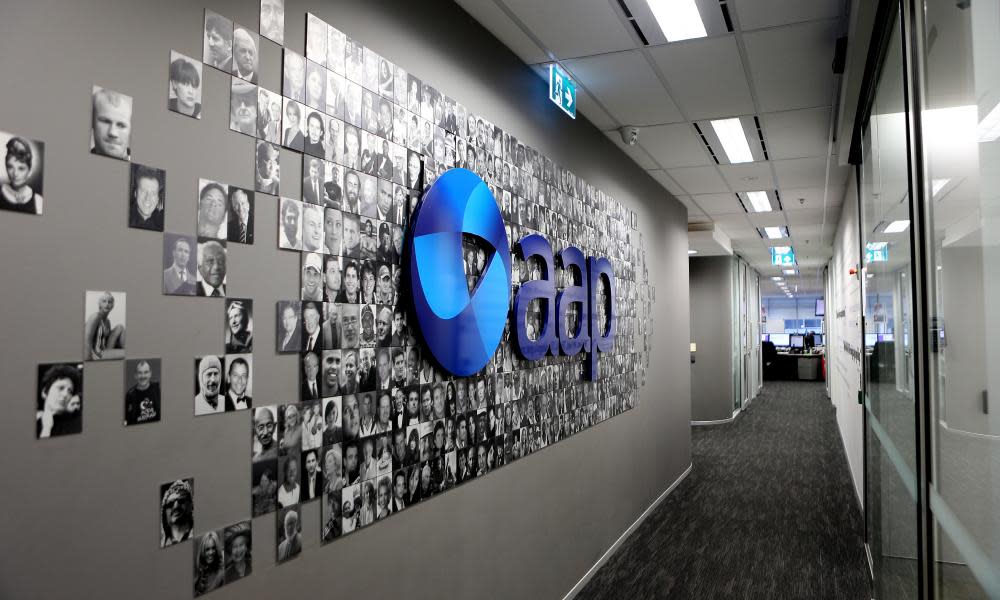AAP bidders likely to shed jobs at newswire service, if they can save it

Jobs cuts appear likely at a pared-back Australian Associated Press focused on its fundamental newswire service, if a consortium of investors and philanthropists is able to save the newswire from closure next month.
But Peter Tonagh, the former News Corp chief executive who is leading the consortium, said the group was concerned with saving as many jobs as possible to help preserve diversity in Australia’s media market, already one of the most concentrated in the democratic world.
“From our perspective, every job matters, every one that we can save is an important job to save,” he told ABC radio.
Reports have suggested the number of journalists could be cut by more than half from 147 to 72, but Tonagh said the size of the cuts was “dependent on a number of factors”, including how much money the consortium could raise.
Related: AAP bid: consumer watchdog warns Nine and News Corp against any attempt to block sale
“There are unfortunately likely to be job losses,” Tonagh said. “The reality is for us it’s that newswire service which is the critical element. It will have to be reconfigured, it probably will be smaller and it probably will address fewer areas.”
Under the consortium’s proposal, AAP’s output would be reduced and streamlined, focusing on breaking news, courts and justice, state and federal politics, and sport.
“These are the bits that we think are the key contributors to the 200 or more customers that draw on AAP journalism for their own services,” Tonagh said, arguing a viable newswire service was vital for media diversity, smaller operators and regional news outlets.
“We know that if we’re unable to provide that daily stream of high-quality news then we’ll see more independent news outlets that fail.”
The consortium’s bid says AAP is recognised as a “critical piece of democratic infrastructure”.
The newswire currently produces about 340 stories a day. Guardian Australia understands that under the consortium’s proposal, that number would be reduced to between 100 and 150 stories, providing “accurate and fair coverage” of key issues, including state and federal politics, the environment, climate change, social inequality, court reporting, sport and special events. The wire would no longer cover finance, entertainment or racing.
The current 24-hour-a-day, seven-day-a-week service would also likely be reduced.
Tonagh said while the consortium was primarily focused on AAP’s newswire service, it was also interested in AAP’s fact-checking unit and photography desk.
Other elements of AAP, such as production and subediting business Pagemasters, the racing and form news, or custom editorial divisions, are understood not to be part of the consortium’s proposed bid, but it is open to acquiring the directories service, Medianet press release service, and analytics business Mediaverse.
AAP, established in 1935 by Keith Murdoch, is owned by Nine, News Corp, Seven West Media and Australian Community Media. News Corp (45%) and Nine (44%) are the major shareholders, and AAP staff were told in March – when the agency’s planned closure was announced – that those shareholders no longer wanted to subsidise a breaking news service for their competitors, such as Guardian Australia.
The head of the Australian Competition and Consumer Commission, Rod Sims, said the commission would welcome the continuation of AAP “in some form”.
“AAP’s continuation is really important for media diversity and also competition. It’s clear to me that media startups and smaller media that want to get bigger, they do depend on AAP.”
Sims warned that any attempt to block a viable sale by current shareholders would be of concern to the regulator.
“Nine and News have said they would close AAP, and we’d be very concerned if they sought to block someone else trying to buy it. That would potentially raise problems under the Competition and Consumer Act.
“If there is a bidder we’ll be watching to ensure there were no inappropriate impediments to sale,” Sims said.
In 2019, AAP had revenue of $65.67m, posting a profit of $1m, after a $10m loss the year before.
But under AAP’s current structure, its two main shareholders, Nine and News Corp, are also its biggest customers. They are expected to leave as customers of the newswire (News Corp has already announced plans to establish an internal wire service), leaving a $15m-a-year hole in AAP’s revenue.
AAP was originally established primarily as a service for its owners, to reduce costs for producing fundamental news content, rather than a revenue stream.
Other commercial elements of the AAP business, such as a service for broadcasters and a media contact database, were later additions.
The AAP chairman and News Corp Australia executive, Campbell Reid, said the offer from the consortium was being considered but declined to go into detail.
“We are treating the conversations as confidential but our primary concern remains for the AAP staff.”
The consortium fronted by Tonagh includes philanthropists, media executives and impact investors, including Fred Woollard, managing director of Samuel Terry Asset Management and Kylie Charlton, managing director of Australian Impact Investments.
In a statement released on Sunday, Tonagh, Woollard and Charlton said their aim was to preserve diversity in Australia’s media market, one of the most concentrated in the democratic world.
“We think we can turn AAP’s business around but we know that if we don’t try, that hundreds of journalists will lose their jobs next month.
“We have raised a significant amount of money but the clock is ticking and the more money we can raise, from philanthropists, impact investors and from government, the more jobs we can save and the more diverse the Australian media will be.”

 Yahoo News
Yahoo News 
